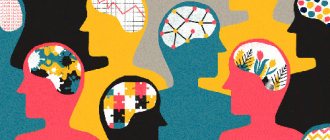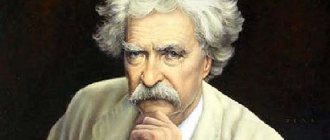Differential psychology is a branch of psychological science that studies psychological differences, typological differences in psychological manifestations among representatives of various social, class, ethnic, age and other groups. This approach is significantly different from others: often in modern psychology they try to identify common psychological processes that are characteristic of all people.
For example, when evaluating the effectiveness of a new therapy, the average effectiveness of the therapy in one treatment group may be compared with the average effectiveness of a placebo (or known therapy) in a control group. In this context, differences between people in their responses to experimental and control manipulations are effectively viewed as errors rather than as interesting phenomena to study.
Individual differences are important when we want to explain how different people behave. In any given study, there is significant variation between the two: response rates, preferences, values, and health-related behaviors are just a few examples. Individual differences in factors such as personality, intelligence, memory, or physical factors (such as height, gender, age, and other parameters) can be used to understand this source of variance.
William Stern is considered the founder of differential psychology, who introduced the concept itself, as well as, interestingly, the term “intelligence quotient.” Of course, this industry was not his pure invention, because traces of it can be found in antiquity. For example, Plato's Republic emphasized the importance of dividing labor according to people's inclinations and abilities. But earlier studies were unsystematic and unrelated to each other.
Tasks of differential psychology
The tasks of differential psychology are mainly aimed at:
- Development of a theoretical basis for psychodiagnostics.
- Determination of patterns and principles of differences between people.
- Studying the features of their manifestation.
- Analysis of the features of type formation in various topologies. An example is the typology of temperament.
- Studying the characteristics of variability of measured traits.
- Analysis of group distribution of characteristics.
Tasks and problems, the solution of which can be found through the efforts of differential psychology, determine the applied bias of this science, which is felt especially strongly in our time.
The results obtained using differential psychology are successfully used in criminology, psychotherapy, education, judicial practice, personnel selection and career guidance.
Sensitivity and thresholds
Definition 1
Sensitivity threshold is a person’s subjective reaction to the impact of traumatic factors that cause pain.
Each person has his own threshold of sensitivity, which is formed at the genetic level. For example, some people are unable to endure a headache, much less work, while others, on the contrary, immerse themselves in work in order to escape from this pain.
Figure 1. Sensitivity thresholds. Author24 - online exchange of student work
If you understand what the sensitivity threshold depends on, then it can be changed using the existing methods.
As a rule, a person can tolerate unpleasant sensations up to a certain point - this point is the pain threshold.
There are no identical pain thresholds, because this indicator is influenced by many factors. In the most unfavorable situation is a person with a low sensitivity threshold; even the simplest procedures, for example, blood sampling, become a real test for him and bring unbearable pain.
Finished works on a similar topic
- Course work Sensitivity thresholds in psychology 460 rub.
- Abstract Sensitivity thresholds in psychology 220 rub.
- Test work Sensitivity thresholds in psychology 200 rub.
Receive completed work or specialist advice on your educational project Find out the cost
People with a low sensitivity threshold should warn doctors in advance if any traumatic surgery is being prepared, in order to avoid psychological trauma. A low sensitivity threshold makes a person’s daily life quite difficult.
The human body with a high pain threshold tolerates stressful situations more easily. Experts have proven that the pain threshold of sensitivity is influenced by a person’s psychotype.
The body becomes more active and prone to extreme situations if the level of fear of physical impact is absent.
Men and women have different sensitivity to pain. Testosterone has an analgesic effect on the male body and, as a result, it is easier to endure injuries.
Experts believe that testosterone levels increase sharply in critical situations and this makes a man forget about danger and pain.
A woman's sensitivity threshold is lower than a man's level, and the lowest level occurs during a woman's critical days. In the morning, the female body is more vulnerable to traumatic influences from the outside. The more sensitive female nervous system causes a woman to succumb to fear and panic more quickly, resulting in a decrease in the threshold of sensitivity at the psychological level.
Too lazy to read?
Ask a question to the experts and get an answer within 15 minutes!
Ask a Question
Nature has arranged it in such a way that at critical moments in life there is a hormonal surge that acts as a pain reliever. This is very important; the level of estrogen, for example, during childbirth becomes higher than all acceptable norms and the pain sensitivity threshold increases significantly, which helps a woman survive.
Diseases of the nervous system, acute and chronic inflammatory processes in the body have a great influence on the pain threshold.
In addition, fatigue, stress, overwork, individual physiological characteristics of the human body are a psychological attitude towards a stressful situation.
However, it must be said that a significant part of these factors can be corrected, and the symptoms of diseases are either completely eliminated or minimized. During therapy, the psychological state can be changed. Vitamins will also be useful.
Methods of differential psychology
The methods used in differential psychology can be divided into several groups:
- general scientific;
- psychogenetic;
- historical;
- psychological.
Let's look at them separately.
General scientific methods
General scientific methods include observation and experiment.
Observation is a descriptive research method that involves purposefully perceiving and recording human behavior.
Benefits of surveillance:
- Reflects the context of the subject's life.
- A person is perceived as a whole person.
- Facts about natural human behavior are collected.
Disadvantages of surveillance:
- Recording the results in a descriptive form.
- Lack of possibility of repeated observation with exactly the same psychological parameters (in addition, the person will behave as he wants, and not as the researchers want).
- The fusion of the observed fact with associated phenomena (the impossibility of separating them in any way).
An experiment is an experience in obtaining scientific knowledge conducted under special conditions. A targeted intervention in a person’s life is carried out.
Unlike observation, an experiment can be repeated many times, and the data are unambiguous and of the same type. The main disadvantage is the disappearance of the naturalness of the process and the lack of a holistic picture of a person’s personality.
If we talk about laboratory experiments, the above-mentioned shortcomings remain. However, a natural experiment is as close as possible to the conditions of normal human activity. In this case, he may not even know that an experiment is being conducted on him.
There is also simulation that attempts to recreate a fictitious psychological reality. The presence of advantages or disadvantages is determined by the skill of execution.
Psychogenetic methods
If general scientific methods are used in psychology in general, then psychogenetic methods are used specifically in differential psychology. This group of methods is aimed at identifying environmental factors and heredity. There are genealogical and twin methods.
Genealogical is a method for researching families and pedigrees (invented by F. Galton and described in the book “Hereditary Genius”). The main point: if a trait is hereditary and encoded in genes, then the closer the relationship, the higher the similarity between people on this trait. The researcher compiles a family tree. Presumably, as the degree of relatedness decreases, less similarity should appear.
Twin method: twins are divided into dizygotic (their gene set is similar to ordinary brothers and sisters, with the only difference being that they were born at the same time) and monozygotic (developed from the same egg and therefore having identical gene sets). In this case, the psychological characteristics of the members of a twin pair are examined, making it possible to determine the degree of influence of hereditary factors and the environment on the formation of certain mental qualities of a person.
Historical methods
Historical methods are used to study the biography of outstanding personalities who made significant contributions to the development of culture and science. But sometimes quite ordinary people become targets.
These methods include diary, biographical and autobiographical.
The diary is devoted to the study of the life of a particular person and contains a description of his behavior and development.
Biographical is used when using the biography of an outstanding personality. If a psychologist is interested in assessing the psychological characteristics of a person, he conducts psychography.
Autobiographical is based on a person’s immediate impressions and retrospective experiences. In its modern form, with its information technology, it has become possible to use video and audio materials.
Psychological methods
Special cases of using these methods are introspection and self-assessment, which directly reveal the object of study.
Self-observation consists of observing one's own mental processes. There is only one advantage, but a key one: a person can know himself better than other people. But the disadvantage is subjectivity, bias.
Self-esteem reflects more stable mental characteristics. The disadvantage of the method is that a person may be ashamed to reveal his qualities or judge them superficially. However, these disadvantages can be brightened up by anonymity (in this case, questionnaires can also be used).
There is no absolutely ideal way of knowing a person, so the main task of psychologists is to combine them, taking into account the advantages and disadvantages of each.
World of Psychology
DISTINCTION
Discrimination
(English: discrimination) - along with detection, recognition, and identification - is one of the 4 main sensory processes: comparison of 2 similar stimuli, usually differing in the value of 1 physical parameter.
See also Reception of information .
(I.G. Skotnikova) Great encyclopedia of psychiatry. Zhmurov V.A.
Discrimination
- the ability to perceive differences between two or more stimuli;
- in perception and psychophysics - the ability to distinguish between stimuli of different intensities;
- in social psychology - not treating individuals or groups equally, based on arbitrary characteristics such as gender, race, ethnicity, culture, etc.
Dictionary of psychiatric terms. V.M. Bleikher, I.V. Crook
no meaning or interpretation of the word
Neurology. Complete explanatory dictionary. Nikiforov A.S.
no meaning or interpretation of the word
Oxford Dictionary of Psychology
Distinction - there are two meanings, one special and "neutral", the other is conceptually based on the special meaning, but is replete with ethical and moral connotations of politics, race, religion, etc.
- in the specialized literature, the ability to perceive differences between two or more stimuli. It can also be considered as a class of experimental procedures, denoted by the general concept of a discrimination learning procedure. For example, in operant conditioning experiments, responses in the presence of one stimulus (SD) are reinforced, but responses in the presence of another (Sdelta) are not. In classical conditioning - in the presence of one stimulus, the CS (conditioned stimulus) and US (unconditioned stimulus) are paired (i.e. the CS is a true CS, usually referred to as CS), but in the presence of another stimulus they are not paired (i.e. the CS here is not a true CS, since it does not serve as a US signal, it is usually designated as CS). In operant conditioning, such learning leads to the production of responses in the presence, but not in the presence of Sdelta. Classically, this leads to the induction of a CR in the presence of a CS, but not in the presence of a CS. In these examples, the term is clearly used to describe a learning procedure by which an organism learns to respond in different ways to different stimuli. Note that the question of acceptance and learning (teaching an organism to detect physical differences between the stimuli themselves) is only indirect. Most discrimination learning procedures assume that the organism perceives differences between stimuli but simply does not respond to them differently because reinforcement has never been applied to teach the organism to treat them differently.
- In perception and psychophysics, the ability to distinguish between stimuli. See threshold (2) for more details.
- The broader meaning, in social psychology and related fields, is not treating individuals or groups equally based on arbitrary characteristics such as race, gender, ethnicity, culture, etc. Without delving into the politics of using this term, it can simply be noted that an accurate understanding of the technical meanings can lead to a good understanding of the problem. See prejudice.
subject area of the term
SENSORY DISCRIMINATION is essentially different responses to different stimuli. If the subject is an organism not endowed with speech, we can say that sensory discrimination between two stimuli occurs when the subject consistently has one reaction to one stimulus and a different reaction to another; with human subjects, a verbal response is sufficient to indicate that a difference has been detected. See distinction.
SPATIAL DISCRIMINATION is a somewhat misleading term used to describe the ability to detect two different points of stimulation on the skin. See two point threshold.
SYSTEM DISCRIMINATION is a process of visual perception that allows us to distinguish between two-dimensional stimuli (such as the words on this page) and three-dimensional stimuli (surrounding objects). Several theories have been put forward to explain the mechanism of this discrimination: Template theory: incoming stimuli are compared with ready-made images (templates) stored in memory. the stimulus is recognized with a close degree of coincidence. Prototype theory: Incoming stimuli are compared to “typical” images of that class of stimuli. For example, if we are asked to imagine a house, most Europeans will find that they have similar ideas about what a house should look like. Everything that corresponds to this image - i.e. has similar features - will be identified as a house.
back to section
:
dictionary of terms
/
glossary / table
Books
This is a brief description of differential psychology as a science. Since the topic is quite complex and voluminous, reading one article will clearly not be enough. Here is a list of books with which you can study it in more detail.
- “Differential Psychology” Sofya Nartova-Bochaver.
- “Differential psychology. Individual and group differences in behavior" Anna Anastasi.
- “Differential psychology and psychodiagnostics” Konstantin Gurevich.
- “Differential psychology: a textbook” Valery Mashkov.
- “Differential Psychology” Alexander Libin.
- “Differential psychology and its methodological foundations” William Stern.
- Neurotic Styles by David Shapiro.
We recommend starting with the book by the founder of differential psychology, William Stern, which is still relevant today.
We wish you good luck!
Did you like the article? Join our communities on social networks or our Telegram channel and don’t miss the release of new useful materials: TelegramVKontakteFacebook
We also recommend reading:
- Storytelling
- Cattell's personality model
- IQ: what is it and how is it measured?
- Psychodiagnostic methods
- Psychosemantics
- Practical psychology
- Wundt's method of studying psychology
- Psycholinguistics as a tool for in-depth study of speech and language
- Cognitive psychology and cognitive psychotherapy
- Situationism in psychology and human behavior
- Criminal psychology
Key words: 1 Communications, 4 Psychoregulation
There are so many fields of activity into which the soul-inspired disciple can go. It is not easy to confidently choose the field of your activity, and in this every aspirant knows confusion. Let us formulate this problem in the form of a question, and make daily efforts to find the answer, since we are not yet in a position where we can comprehend how the soul can “dissipate its forces” on the higher planes.
What is the criterion by which a person can understand which of several directions of activity will be correct to follow? In other words, is there something that allows a person to accurately choose the right action and follow the right path? This question has nothing to do with the choice between the path of spiritual aspiration and the path of an ordinary person. It concerns the right action when we are faced with a choice.
There is no doubt that in his progress a person is faced with the need to distinguish more and more subtle nuances. The crude choice between right and wrong, which preoccupies the infant soul, is replaced by finer distinctions between right and more right, between high and still higher, and moral or spiritual values must be subjected to the most meticulous spiritual analysis. In the stress and work of life, in conditions of constant pressure on each person from those who are part of his group, this problem becomes very complex.
In solving such problems, certain gross distinctions may precede more subtle ones, after which even more subtle distinctions will follow. The choice between selfish and unselfish action is the most obvious one in the choice between right and wrong and is easily resolved by an honest soul. A choice that involves the distinction between individual and group good quickly eliminates all other considerations and is easy for a person who is aware of his true responsibility. Note the words “recognizes his true responsibility.” We are talking about an ordinary, normal person, and not about a super-conscious, super-impressionable fanatic. What follows is a distinction between modes of action (including business and financial relationships on the physical plane) that lead to the identification of the highest good for all parties involved. But, having reached a certain place as a result of this triple selection process, we are faced with cases where there is still a choice in which neither common sense nor logical analytical constructions help. The desire to do the right thing remains; the intention remains to act in the highest possible manner, to choose the line of action that will bring the greatest good to the group, regardless of personal considerations. And yet the light on the path you are walking is not yet visible; the door through which one must enter is not recognized, and the person remains in a constant state of doubt. What to do then? One out of two.
First: the aspirant can follow his inclination, what he is predisposed to, and choose that line of action that seems to him the wisest and best of all possible. This includes faith in the operation of the Law of Karma, as well as the demonstration of firm determination, which is the best way in which his personality can learn to act in accordance with the decisions of his own soul. It also includes the ability to move forward with a decision and face the consequences without fear or regret.
Second: he can wait, relying on his inner sense, knowing that at the right time he will discern, after closing all the doors except one, the path along which he must go. Because there is only one open door through which such a person can pass. To recognize it, you need intuition. In the first case, mistakes can be made that teach and enrich a person; in the second case, mistakes are impossible and only the correct action can be taken.
So, obviously, it all comes down to understanding your place on the ladder of evolution. Only a highly advanced person can know times and cycles and can adequately recognize the subtle difference between psychic sensitivity and intuition.
In considering both paths, in making the final decision, let the man, who must use his common sense and choose a course of action based on his particular mind, not practice the higher method of waiting for the right door to open. He wants too much for the level of development at which he is. He will have to learn to solve his problems through the choice of the right solution and the correct use of his mind. Through this method it will grow because the roots of intuitive knowledge lie deep in the soul and therefore it is necessary to contact the soul before intuition can work. Here we can give only one hint: intuition is always connected with group activity, and not with personal small matters. If you are still a person centered in your personality, realize this and, based on your equipment, manage your actions. If you know that you are functioning as a soul and that you are concerned only with the interests of others, unaffected by your own egoistic desire, then what is required of you will become clear to you, your sense of responsibility will be strengthened, your group work will advance, and the path will open. before you as you do the next thing, fulfill the next obligation. One task, perfectly executed, will provide an opportunity to engage in higher and more responsible affairs, which we call world work; responsibility to family will strengthen us and allow us to take responsibility for a larger group. What then is the criterion?
For the advanced aspirant, let me repeat, the choice of action depends on the right use of the lower mind, on the use of common sense and on how far he has forgotten his selfish love of comfort and personal ambition.
This leads to the fulfillment of duty. The student automatically and necessarily does everything described above, and his intuition helps him feel the moment when he can take on greater group responsibility without relieving himself of responsibility for his small group. Think about it. Intuition does not open the way to feeding personal ambition and does not provide a way to satisfy the egoistic desire for personal growth. "Treatise on White Magic" [04-0067]









